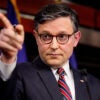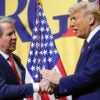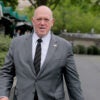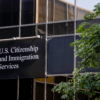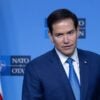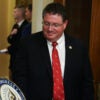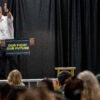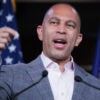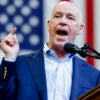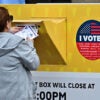This week on “Problematic Women” we talk with Lindsey Burke, The Heritage Foundation’s education fellow, about a new collection of essays, “The Not-So-Great Society.” Burke, co-editor of the project, discusses what Lyndon B. Johnson’s programs really did for public education, and it’s little that is positive. She also suggests how we can begin to solve the problems the government has inflicted on the education system.
We also break down these stories:
- When England’s first Chick-fil-A is met with LGBT protests to “get the chick out,” its lease is not renewed.
- A recent episode of “Law and Order: SVU” trashes the pro-life movement. We discuss the media’s power in shaping ideas and how to respond to pro-choice messages.
- Kanye West tells wife Kim Kardashian that her Met Gala dress is “too sexy.”
The Daily Signal depends on the support of readers like you. Donate now
And our Problematic Woman of the Week is The Heritage Foundation’s Lindsey Burke, co-editor of “The Not-So-Great Society.” Get the book here. For the interview with her, listen to the podcast or read the lightly edited transcript below.
Lauren Evans: We are here at The Heritage Foundation’s President’s Club, where we are joined by Heritage’s education research fellow, Lindsey Burke. And she has just released a new book, “The Not-So-Great Society.” Welcome, Lindsey.
Lindsey Burke: Thank you for having me.
Virginia Allen: All right, Lindsey, let’s jump right in. I want to start with the title of the book. It’s pretty unique, “The Not-So-Great Society,” and in that title you’re referring back to President Lyndon B. Johnson, who in the 1960s launched a set of domestic programs that were intended to better society.
There was a large focus on the education system, but can you tell us a little bit more about what President Johnson’s Great Society was really intended to do and what was the effect that it had on public education?
Burke: Yeah, I think that’s a really good way to frame it. What was it intended to do and what were the actual outcomes? I’m reminded of the quote that [economist] Milton Friedman said about intentions, right? He said, “One of the great mistakes is to judge policies and programs by their intentions, rather than by their results.”
I think we have to put the Great Society, all of the programs that it initiated, in that bucket. That while there were intentions on the part of President—and we can debate what those intentions might’ve been—the outcomes have been lackluster, to put it mildly.
The Great Society, when it kicked off in 1965, Johnson said [of] the war on poverty [that] one-third of it would be fought in the classrooms of America. And what that did was it set the stage for a federal preschool program known as Head Start that still exists today.
A K-12 system of programs in the Elementary and Secondary Education Act, which everybody might know better, it eventually became known as No Child Left Behind. And then The Higher Education Act, which got the federal government into the game of underwriting student loans for students across the country.
The outcomes of those programs have really been subpar, to say the least. And in the case of higher ed in particular really produced, I would argue, the exact opposite outcome of the intentions that were laid out at 1965.
Evans: So when did this start going wrong? Was the program kind of a failure from the start? Are we just now seeing these negative consequences?
Burke: It really was a failure from the start. Now we have about a half-century to really evaluate exactly what those failures were and how bad they were. I think one of the unique contributions of this book is to sort of take that long view and look at all of the various outcomes.
But I would argue it really started from the moment that we got the federal government so intrinsically involved in education policy, which we did in ’65. If you look back to the early days of the republic, there was really no federal involvement whatsoever in education. We actually got a really small Department of Education that popped up in 1867, but it was downgraded a year later to a small little Office of Education to gather statistics.
And then if you fast-forward a little bit, in 1944 we get the GI Bill. And the GI Bill, which we all know supported returning [World War II] service members who wanted to go to college. But the GI Bill was really one of the first sort of significant pieces of the federal government getting involved.
That was it. From the beginning of the republic to the GI Bill, you had very, very modest federal involvement. The national school lunch program pops up, but it’s modest.
And then all of a sudden something changes. In 1957, we see the Soviets launch Sputnik. And this is of course the first earth-orbiting satellite. And then a month later, in November of ’57, they launch Sputnik II. And at that point, President Eisenhower says, “OK, we’ve got to leverage the federal government to provide some additional federal spending to support scientists and mathematicians.”
But at that point it was really a national security prerogative. So it was appropriate for the federal government to spend some money. But what the Great Society did was it turned that on its head. And so you get Lyndon Johnson, who comes in as president in 1964, and in his first State of the Union address, he announces an all-out war on poverty in America.
That was really the catalyst for this huge Great Society push that he eventually laid out and got signed into law, that affected everything from grade school to grad school.
So we can talk a little bit about the outcomes of those programs specifically, but they have been poor to say the least when it comes to preschool. They have not moved the needle at all in terms of K-12 policy, and they have led to massive increases in college costs at the higher education level.
Evans: And before these federal education programs were created, it wasn’t like this was when public education started. Just before then it was left up to the states, correct?
Burke: That’s right. And localities even better. It’s a really good question because for the most part, education is a state and local issue. And even in the wake of all of the federal intervention that Johnson catalyzed, today the federal government is still just an 8.5% stakeholder on all K-12 education spending.
So education is a quintessentially state and local issue. It’s about a 45/45 split if we want to get really technical in the revenue at the state and local level. But it is something that is supposed to be locally driven. It’s supposed to be close to families. Programs and education are supposed to be situated closest to the people that they impact.
Which is why it was so ill advised from the very beginning, to get to your earlier point about having the federal government enter that domain. The federal government is the farthest it can possibly be from the students and families and individuals these programs impact.
Allen: So let’s wait a minute to talk about the effect that it’s had on colleges. Let’s start with elementary and high school. What did we have before that was so good? And then what have we lost within elementary and high school with the implementation of the Great Society?
Burke: That’s a great question. At the K-12 level, the elementary and high school level, we have seen completely flat academic outcomes since the program began in ’65. We have a chapter in our book, “The Not-So-Great Society,” by Harvard’s Paul Peterson. And he talks about how in 1965 students who are low income and students who were upper income, from upper-income families, there was a four-grade-level difference in learning between those students.
Today, that difference is four grade levels worth of learning. We have not moved the needle whatsoever in terms of narrowing that achievement gap between poor children and their more affluent peers.
We have not moved the needle in terms of graduation rates for disadvantaged children. We are still in the middle of the pack internationally. We’re not competitive internationally when we look at other countries around the world, and so the needle has essentially been flat.
If you look at metrics, take for instance reading achievement among high school seniors. Reading achievement is the same today as it was when those Great Society programs passed. So on every metric that you can look at, we have not seen the needle move whatsoever in elementary and secondary education.
And I should add, we have seen per-pupil federal education dollars quadruple in real terms since the Great Society launched. So a fourfold inflation-adjusted increase in spending, and we have bought with that a 137% increase in nonteaching staff.
So that’s basically what we got. We got no improvement in terms of academic outcomes, but we got a public education system that saw significant nonteaching, administrative bloat in the wake of the Great Society.
Evans: And Lindsey, I know you’re not an economist, but where does that money come from?
Burke: I am not an economist, but I can tell you that it comes from you and me. I mean, it is taxpayer-supported, and that’s a really interesting segue I think into the higher ed component and the impact of the Great Society. Prior to the Great Society initiative in ’65, most students paid their way to go to college and college was relatively affordable.
What we got, though, when we had massive federal subsidization after the Great Society launched, this was the Higher Education Act. It got signed into law in ’65, and for the first time it puts the full faith and credit of Uncle Sam behind private student loans. A massive increase in federal subsidies for higher ed. So what that did was that laid the groundwork for where we are today, which is a federal government that originates and services and directly provides 90% of all student loans across the country.
What that means: Not only has it made college less affordable, but to quote Richard Vedder, who is an economist at the University of Ohio who also has a chapter in our book: “Basically, the federal government has been dumping money out of airplanes onto universities.”
And so of course that enables them to spend profligately. To create climbing walls and lazy rivers and tiger grottoes, to not be remotely fiscally responsible with their money because they know that they can pass that tab onto students, who get easy access to federal student loans with virtually no credit check. Then if they default or if there’s loan forgiveness, because the federal government subsidizes 90% of all student loans, that bill is paid by taxpayers when students default.
And so we’re in a really tenuous situation in higher education financing. We have $1.6 trillion in outstanding student loan debt today in America. That is breathtaking. It’s not going away anytime soon, and the policies that exist today because of the Great Society programs are what have led to that situation being the case.
Allen: So we really saw the exact opposite effect …
Burke: Yes.
Allen: … of what it was supposed to do, right?
Burke: Exactly.
Evans: Interesting. Exactly. And I should say on that too, the whole Great Society initiative, a big part is the War on Poverty?
Burke: It was to ostensibly help lower-income individuals climb the ladder of economic mobility. It failed in the K-12 realm, as we talked about. And in higher education, Richard Vedder in our book talks about a slightly lower proportion of low-income students today attend college than they did in 1965. So it’s failed on every measure to try to improve outcomes for low-income Americans.
Allen: So where would you begin to try to fix this? It’s such a massive issue, and maybe it’s two very separate answers [on] what would fix elementary and high school versus college. What would you say to that?
Burke: I think that overarching answer is the same, and we say this in our book. The first step is a bold one and it is to get the federal government out of these programs, from preschool through grad school.
That it is a sort of [a] technical fix in a way, because the federal government is intrinsically involved in all education policy today. That includes having programs over at the Department of Health and Human Services. This is where Head Start is located. Of course, the federal Department of Education. There are programs over at DOD [the Department of Defense].
Education programs are everywhere in the federal government, but what we should start thinking about is how we wind down the Department of Education as a Cabinet-level agency. And for those programs that are constitutional, are performing well, where do we house those programs?
Do we think about maybe Treasury can manage student loans, for instance? Do we think about putting some of these statistic reviews that the federal government currently does with the Department of Ed over at the Census Bureau? There are ways to think about how we technically wind down the department as a Cabinet-level agency.
Remember the Department of Education has only been around since 1980, right? It hasn’t been around forever. What that does is you sort of rebalance power over education and you start to pull that power back down to the state and local level and ultimately family level, where it belongs. Because at the end of the day, the heart of the problem with the Great Society is that it created this fundamental misalignment of power and incentives.
It really shifted the locus of power of control to the federal government and out of the hands of localities and states and ultimately families. And so winding down federal intervention means putting it back in the hands of state [and] local leaders and ultimately parents.
Evans: I’m glad you said that, Lindsey, because that gets into my next question. With that vacuum, as government takes up more space and leaves less space for parents to be involved …
Burke: That’s right.
Evans: How does that actually affect an individual student?
Burke: That’s a great question and this is one of the thrusts of our book is to say, “You know, we’ve had half a century to look at the Great Society and see that it has been the Not-So-Great Society and has failed, and we need to basically rebalance to states, localities, and families and civil society at the end of the day.
When you empower civil society, that means local community options, not federal government options, you ultimately empower families because they have access to options that are situated closest to them. So it means making space for things like education choice programs to flourish at the state and local level.
At the higher education level, it means getting Uncle Sam out of the student loan business so that private providers can enter the market again. We used to have a thriving private student loan market. But even better, it allows innovative options like income share agreements, for instance, to bubble up from the surface.
If you look at a place like Purdue University, there are really great examples. Purdue is offering income share agreements to some of its students and basically that enables the student to pay nothing upfront for college. And Purdue, as a result of offsetting that cost upfront, knows exactly how much that student is likely to earn if they enter engineering versus another field. They can set their interest rates accordingly. And then once the student has a job, Purdue receives a portion of their income on the back end.
These are innovative options that are not debt-based in the way that we’ve traditionally thought about them, and they certainly get taxpayers off the hook for financing student loans. So, we move the federal government out and we make space for civil society options like that to reemerge.
Allen: I’m glad that you brought that up because one of the awesome women that we’ve celebrated on this podcast is Virginia Walden Ford. And you know her and she played such a critical role in D.C. in providing a program where students could take that little bit of money and actually apply it to going to a private school or a charter school. Are we seeing more and more of those programs emerge?
Burke: You know, it’s so interesting because if we think about the Great Society, it was 1965. A few years prior to that, in 1955, we had something else come out and that was the essay written by Milton Friedman for the first time in which he formalized the idea basically of a school voucher. And it was in that 1955 essay that he said, “Let’s separate the financing of education from the delivery of services.”
And so I like to think about the fact that we basically had two competing ideas moving forward, sort of in tandem, right? Milton Friedman’s idea of freedom and education, and then the top-down, heavy-handed, Great Society failure that we’ve seen. But ultimately Milton Friedman’s idea is winning out and honestly, it had remained an academic idea until about 1990.
We didn’t see a lot of school choice before 1990. But then all of a sudden we get the first program [in] Milwaukee, Wisconsin, in ’91. We get a school voucher program. Then throughout the ’90s we see a couple of other programs. Today, we have 63 private school choice programs in 29 states and in D.C. And Virginia Walden Ford is really … we call her the mother of the D.C. voucher program.
It was because of her that that program began in Washington, D.C., in 2003, and it is not hyperbolic to say that it has saved the lives—and Virginia herself saved the lives—of thousands of D.C. children as a result. They have been able to escape failing and unsafe and unsatisfactory public schools in Washington, D.C., and attend a private school of choice where they’re safe and they’re learning and their parents are happy and they’re satisfied.
That is all because they’re able to select a school where the learning options reflect their values and their hopes and their aspirations for their lives long term. That’s sort of the student-level story of it.
And when we look at the data … we’re here at President’s Club, we heard yesterday from Dr. Patrick Wolf, who’s at the University of Arkansas, he walked us through the research. When we look at the research, it is overwhelmingly positive on the benefits of school choice. …
There are 16 randomized, controlled trial evaluations that look at the impact of school choice on academic achievement, and 10 of those find statistically significant improvements for students. We have four that have no effects, so no difference between public and private school choice options. And then two that have negative effects. But those two were both from Louisiana, which is a uniquely heavily regulated state.
I say all that to say the impact of school choice, the literature shows it is positive on balance, that kids are performing phenomenally as a result. That’s all because we’re putting power in the hands of parents and quite frankly, putting some much-needed competitive pressure on the public school systems to improve and to be responsive to families.
Evans: So, Lindsey, a lot of our listeners are probably not quite parent age, but what is someone who’s, you know, 18, 19, 20, 25, what should they be thinking about school choice?
Burke: I’m not being that much older now, but I think all the time about how our education system, just the way it operates is anathema to every other aspect of American life. Everything we do every day.
Like before we started this podcast a few minutes ago, somebody said, “Should I pull up the Starbucks app to put in my order?” Right? We expect customization with everything. I got here in an Uber this morning that picked me up from my house and brought me here where I needed to be in very quick order.
We do everything on demand from what we watch on TV to what we order, right? We have Uber Eats. We have scooters. We have Lime, you know? Everything is just totally, totally customized, except for our education system.
We assign students based on their parents’ ZIP code, which means low-income families are the ones who have the least power in that system. We assign students based on their ZIP codes, to whatever government-run school happens to be closest to where their parents can afford to live.
What else do we do that operates that way? The post office, maybe. The DMV. That’s about it. So we have this system in education that looks more like a monopoly than a market. Much more like a monopoly than any sort of customized option everybody under 25 would demand in any other sector.
I think eventually, honestly, it’s going to work itself out. Because I think the under-25 crowd is so used to that customization, that once they get to the point where they are having kids of their own and have to navigate that school system, they will be completely dumbfounded by the fact that they cannot customize it the way they customize everything else.
Allen: The book is called “The Not-So-Great Society.” Lindsey, where can it be found?
Burke: You can go to heritage.org/the-not-so-great-society, and you can request a copy there and it will be delivered to your door, customized and on demand.
Allen: Wow, that’s so great. So convenient.
Evans: Lindsey, thank you so much for joining us today.
Burke: Thank you for having me.
